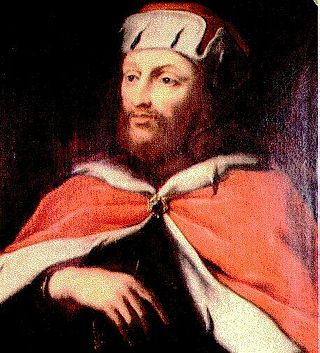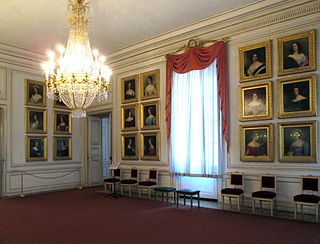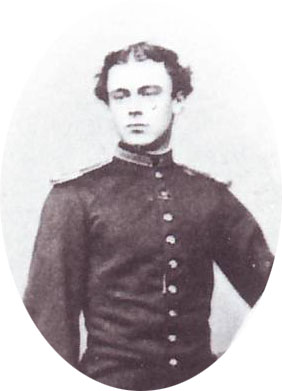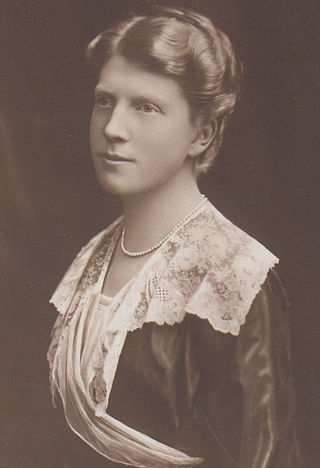Related Research Articles

The House of Wittelsbach is a former Bavarian dynasty, with branches that have ruled over territories including the Electorate of Bavaria, the Electoral Palatinate, the Electorate of Cologne, Holland, Zeeland, Sweden, Denmark, Norway, Hungary, Bohemia, and Greece. Their ancestral lands of Bavaria and the Palatinate were prince-electorates, and the family had three of its members elected emperors and kings of the Holy Roman Empire. They ruled over the Kingdom of Bavaria which was created in 1805 and continued to exist until 1918.

Maximilian I Joseph was Duke of Zweibrücken from 1795 to 1799, prince-elector of Bavaria from 1799 to 1806, then King of Bavaria from 1806 to 1825. He was a member of the House of Palatinate-Birkenfeld-Zweibrücken, a branch of the House of Wittelsbach.

Ludwig III was the last King of Bavaria, reigning from 1913 to 1918. Initially, he served in the Bavarian military as a lieutenant and went on to hold the rank of Oberleutnant during the Austro-Prussian War. He entered politics at the age of 18 becoming a member of the Bavarian parliament and was a keen participant in politics, supporting electoral reforms. Later in life, he served as regent and de facto head of state from 1912 to 1913, ruling for his cousin, Otto. After the Bavarian parliament passed a law allowing him to do so, Ludwig deposed Otto and assumed the throne for himself. He led Bavaria during World War I. His short reign was seen as championing conservative causes and he was influenced by the Catholic encyclical Rerum novarum.

Countess Marie Louise Larisch von Moennich was a niece and lady-in-waiting of Empress Elisabeth of Austria. She was implicated in the Mayerling Incident which resulted in the death of her married cousin Crown Prince Rudolf and his mistress Baroness Mary Vetsera, who was also her friend. She published several books with a ghostwriter about the Imperial household.

Otto I, called the Redhead, was Duke of Bavaria from 1180 until his death. He was also called Otto VI as Count Palatine of Bavaria from 1156 to 1180. He was the first Bavarian ruler from the House of Wittelsbach, a dynasty which reigned until the abdication of King Ludwig III of Bavaria in the German Revolution of 1918.

Daisy, Princess of Pless was a noted society beauty in the Edwardian period. During her marriage, she was a member of one of the wealthiest European noble families. Daisy and her husband Prince Hans Heinrich XV were the owners of large estates and coal mines in Silesia which brought an enormous fortune to the Hochbergs.

Prince Ludwig Ferdinand Maria Karl Heinrich Adalbert Franz Philipp Andreas Konstantin of Bavaria was a member of the Bavarian House of Wittelsbach and a General of Cavalry. Following his marriage to Infanta María de la Paz of Spain, he was also created an Infante of Spain.

Infanta Amalia of Spain was the youngest daughter of Infante Francisco de Paula of Spain. Her eldest brother, Francisco de Asís married Queen Isabella II of Spain, who was Amalia's first cousin. She was one of only two of five sisters who made a royal marriage. In 1865 she married Prince Adalbert of Bavaria, a son of King Ludwig I of Bavaria. Upon her marriage she moved to Munich, where she spent the rest of her life. However she remained attached to her native country and was instrumental in arranging the marriage of her eldest son Prince Ludwig Ferdinand of Bavaria with her niece Infanta Paz of Spain.

Infanta María de la Paz of Spain was a Spanish infanta. A daughter of Queen Isabella II, she married her cousin Prince Ludwig Ferdinand of Bavaria. She lived the rest of her life in Germany, dedicating her time to her family, charity work and writing poetry. She wrote a book of memoirs: Through Four Revolutions: 1862–1933.

The Duchy of Pless was a Duchy of Silesia, with its capital at Pless.

Leopold Rupprecht Ludwig Ferdinand Adalbert Friedrich Maria et omnes sancti Prinz von Bayern is a member of the Bavarian royal house of Wittelsbach and a former champion race car driver. He descends from King Ludwig I of Bavaria in direct line and is a distant relative to the current head of the House of Wittelsbach, Franz, Duke of Bavaria and his brother, Maximilian, Duke in Bavaria. He also descends from Austrian Emperor Franz Joseph and his wife Elisabeth and from King George II of Great Britain, and is therefore a distant cousin of Elizabeth II. As a Roman Catholic he is excluded from the line for the British throne by the Act of Settlement 1701. He also descends from Isabella II of Spain, through her daughter, and Leopold's great-grandmother, María de la Paz. He has a claim to the Throne of Portugal.

The Gallery of Beauties is a collection of 38 portraits of the most beautiful women from the nobility and bourgeoisie of Munich, Germany, gathered by Ludwig I of Bavaria in the south pavilion of his Nymphenburg Palace. All but two of the portraits were painted between 1827 – 1850 by Joseph Karl Stieler, with two additional portraits created by Friedrich Dürck, a student of Stieler's. The collection's best-known works are the portraits of the shoemaker's daughter Helene Sedlmayr, the actress Charlotte von Hagn, Marianna Marquesa Florenzi, and Eliza Gilbert. They also include a Briton, a Greek, a Scot and an Israelite, along with relations of Ludwig's – the wife and daughter of Ludwig of Oettingen-Wallerstein were both painted, as was Ludwig I's daughter Princess Alexandra of Bavaria. All 38 women pictured were rewarded for modeling by Ludwig I. He took over their dowry, paid them an allowance or found them a job at court. He remained in active correspondence with some of them for years, while others only briefly crossed his life.

The Order of Theresa was an order for noble ladies in the Kingdom of Bavaria. It continues to function today as an honorary society to which belong the princesses of the House of Wittelsbach as well as other ladies from Bavarian noble families.

Wagner is a 1983 television miniseries on the life of Richard Wagner with Richard Burton in the title role. It was directed by Tony Palmer and written by Charles Wood. The film was later released on DVD as a ten-part miniseries.

Prince Ferdinand Maria of Bavaria was a prince of the House of Wittelsbach and Infante of Spain, the eldest son and child of Ludwig Ferdinand of Bavaria and his wife, Infanta María de la Paz of Spain. Ferdinand became an Infante of Spain on 20 October 1905 and renounced his rights to the throne of the Kingdom of Bavaria in 1914.

Ludwig II, also called the Swan King or the Fairy Tale King, was King of Bavaria from 1864 until his death in 1886. He also held the titles of Count Palatine of the Rhine, Duke of Bavaria, Duke of Franconia, and Duke in Swabia. Outside Germany, he is at times called "the Mad King" or "Mad King Ludwig".

Paul Maximilian Lamoral, Prince of Thurn and Taxis, was the third child of Maximilian Karl, 6th Prince of Thurn and Taxis and his second wife Princess Mathilde Sophie of Oettingen-Oettingen and Oettingen-Spielberg. He was buried in Cannes, at the Cimetière du Grand Jas, Allée du Silence no. 33 under the name of Paul de Fels.

Sir Sidney James Mark Low was a British journalist, historian, and essayist.

Princess Pilar of Bavaria was a German Royal, the only daughter of Prince Ludwig Ferdinand of Bavaria and his wife Infanta Maria de la Paz of Spain.

Villa la Vigie is a villa in Roquebrune-Cap-Martin on the Cote d'Azur in southern France. It was built by the British publisher Sir William Ingram, 1st Baronet in 1902 and occupied and renovated by the fashion designer Karl Lagerfeld in the 1980s.
References
- 1 2 Cf. WBIS. The associated WBIS entry was taken over by Who's Who on the stage, 1907.
- ↑ His mother was a grandniece of Sir Benjamin Chapman, 4th Baronet and Lord Lieutenant of County Westmeath.
- ↑ Cf. his letter to the editor in The Times, 7. May 1919, p. 8.
- ↑ Cf. his letter to the editor in the Times, 25. January 1934, which was shipped from Munich.
- ↑ Cf. The Geographical Journal, Volume 85, Issue 1, January 1935, p. 79.
- ↑ Ludwig II. The Mad King of Bavaria, Dorsett Press, New York 1990, ISBN 0-88029-493-0; also: Barnes & Noble, New York 1993, ISBN 0-88029-493-0.
- ↑ W. John Koch (2006). Daisy von Pless: Eine Entdeckung. Edmonton: W. John Koch Publishing. p. 66. ISBN 0-9731579-3-3.